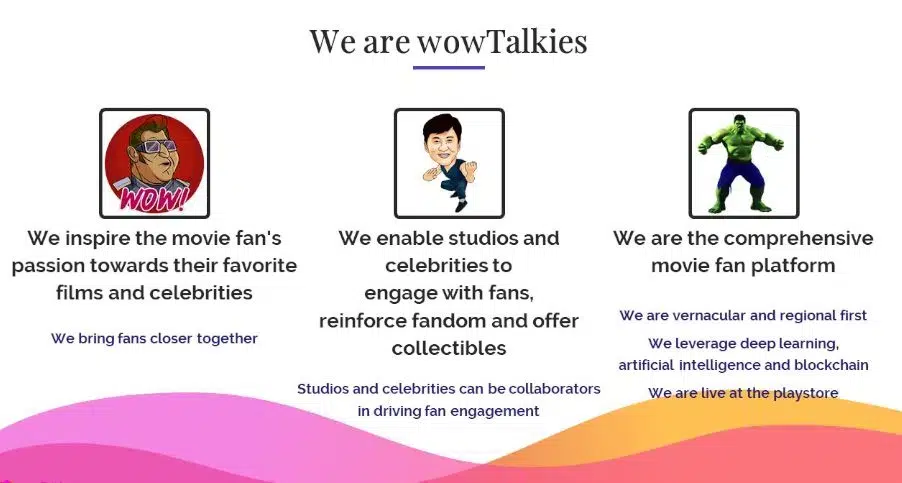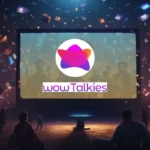Fan engagement in Web3 has undertaken a unique path compared to the engagement methods in Web2 and traditional media. Historically, organizations that have relied on traditional media (Television, Radio, and Print) to engage fans, are missing out. The media as we know it today was different back then. Communication was one-way, and as a result, engaging fans was less interactive.
- Less Gatekeeping, More Fan Engagement in Web3
- The Emergence of Web3
- Fan Engagement in Web3 Vs Web2
- What Problem Does Fan Engagement in WEB3 Solve?
- Decentralized Autonomous Organizations or DAOs for Fan Engagement in Web3
- Tokenization and Fan Engagement in Web3
- Smart Contracts are the Backbone of Fan Engagement in Web3
- Augmented Reality, the Metaverse
- Will Entertainment Brands be Quick to Adopt Web3
- How wowTalkies is Revolutionizing Fan Engagement in Web3, Entertainment, and Community
- A Platform for Fans: Fraternize, Climb, Create
- Empowering Artists: Engage, Create, and Be Rewarded
- Studios Unite: Community Building and Beyond
- Community-Centric Approach: Wisdom, Content, and Rewards
- Meet the Team Behind the Innovation
- Guidance from Visionaries: Meet the Advisors
- The Future of Fan Engagement in Web3
- Account Abstraction or AA
- Cryptocurrencies and Smart Contract Composability
- Utility NFTs for Fan Engagement in Web3
- In-Game Assets
- Stealth Addresses
- Conclusion of Fan Engagement in Web3
The internet bubble of the late 90s led to increased content distribution through file-sharing and Compact Disc (CD) sales. Musicians and recording labels were among the first creators to adopt the Internet as a means to sell their work. In this blog post, we focus on fan engagement in Web3 and how entertainment brands are moving from the old internet (Web2) when engaging their fans.
Less Gatekeeping, More Fan Engagement in Web3
In other words, the internet was the best medium for fan engagement in those days when it bubbled. However, engagement was still relatively low and one-way until the advent of social media in the mid-2000s. Around the same time, video-sharing companies like YouTube and Vimeo also started gaining considerable traction. This age witnessed the rise of successful business models around user-generated content; brands could even connect directly with creators, and the experience was nothing less than personalized.
Simply, creators, influencers, and brands flourished at a time when communication across all parties grew more interactive.
Despite transforming some personal brands, sports athletes, and artists into success stories, the digitization of content creation did not satisfy everyone involved as was hoped. Particularly, creators found themselves at the lowest end of the value chain. Not to speak about the audience/fans who found themselves baked and packaged into a product for data extortion.
The primary winners of the content digitization age were video-sharing platforms like YouTube, Social media giants such as Facebook and Twitter, and content subscription services such as Apple Music and Spotify. All of these platforms are centralized in nature. To build a business model around content distribution that would compensate all participants equally and fairly, innovators had to deal with the elephant in the room – centralization.
The Emergence of Web3
Today, the emergence of Web3 and deep tech opens up the content industry to decentralization and evermore immersive experiences. Creators can take advantage of the decentralization aspect of the blockchain to connect directly with their fans. It bears mentioning that some of the artists, entertainers, and creators who have maintained direct links with their audiences, are the ones who gained more influence and compensation even during the social media bubble.
In this blog, we explore how brands in sports and entertainment can leverage web3 and build reliable fan engagement models. The next section dissects the features of Web3 and how they elevate the fan engagement experience. Some of these aspects include DAOs, NFTs, the Metaverse, Openness and Diversity, Transparency and Data Privacy. The goal of the next section is to discuss how these Web3 features solve problems of fan engagement in Web2.
Fan Engagement in Web3 Vs Web2

The brand is leveraging the power of NFTs as the primary catalyst for elevated engagement, but to increase fun, brands can also build their personalized entertainment experience for the fans. The first step for fan engagement in Web3 and in Web2 is an Entertainment-first approach. This approach offers fans a valid reason to interact with the personalities, other fans or entertainment brands.
However, the means, structure and technology for elevated fan engagement changes between Web2 and Web3. Below are some of the distinct features that define fan engagement in Web3 Vs fan engagement in Web2.
Decentralized Control
Web3 aims to foster a decentralized environment that abides by the ethos of transparency, community governance, user control and P2P interactions. This not only places engagement, rewards and control in the hands of users but also eliminates manipulation by central authorities.
Web2 on the other hand places the control of fan engagement platforms in the hands of a centralized entity.For instance, Web2 engagement platforms like X and Facebook operate the entities,moderate content, censor users and control user data.
Ownership
In Web3, users have great control over the platform, data and digital assets. Blockchain technology has enabled users to tokenize their digital content into unique Non-fungible Tokens (NFTs). They may choose to monetize their content through selling the content on NFT marketplaces or lending them on NFT lending/borrowing platforms.
On the other hand, Web2 limits user ownership and places control of digital assets and data under the platform. Fan engagement platforms in Web2 are notorious for transforming their users into products by monetizing personal data. Sometimes, users face restrictions when generating or distributing content.
Community Governance
Web3 platforms pay particular attention to community-led decision-making to impact platform growth and evolution. This not only fosters inclusivity but establishes a participatory environment for everyone to lead.
Some of the challenges that wowTalkies wants to tackle using fan engagement in Web3 include the centralized policy-making process across Web2 platforms, limited user influence on decisions, closed systems, and profit-driven corporate interest that maximizes revenue for shareholders instead of the end users.
Experts believe it’s time for fans to engage to earn. Web3 fan engagement aims to foster democratic decentralized governance, transparency, token-based voting, programmable smart contracts for governance rules, and community incentives for participating in governance.
What Problem Does Fan Engagement in WEB3 Solve?
Fan engagement is a connection-building process between an entertainment brand and its audience. ‘Fan engagement is not an overnight thing’ a common sentiment across the entertainment industry shows the sheer longevity it could take to build a valuable audience. As such, brands ought to have a long-term mindset when building a strategy for engaging their fans at a deeper level. In essence, some of the problems that Web3 intends to solve have been around for decades. While still very promising and innovative, Web3 can be dangerous territory when done without a plan.
Nevertheless, it’s common for all innovations to stir fear, yet it’s upon entrepreneurs to embrace change, difficult as it might be. Why? Because some of the challenges facing fan engagement today require a shift in mindset. Let’s look at some of those problems that fan engagement in Web3 solves:
- Limited attention span
- Dwindling revenue streams
- Demand for more personalized fan experiences
- The Need for Diversity, Inclusivity, Fairness and Community
- Generational shifts in demands
- Quality Control in the Age of Scaling and Competition
Before discussing how Web3 can solve the 6 challenges facing engagement, it’s important to acknowledge the need for constant innovation and adaptation. Business leaders in the entertainment sector ought to know that getting it right in Web3 fan engagement will be an iterative process; one that will require gradual refinement over time.
Some brands have innovated to an extent we can call” successful”, however, this is not to say they have gotten 100% of fan engagement using Web3. In discussing “what problems Web3 solves in Fan Engagement” We must consider the following Web3 features:
Decentralized Autonomous Organizations or DAOs for Fan Engagement in Web3
The DAO is redefining traditional entertainment property ownership, more importantly in the shareholding of sports clubs and production studios.
A Decentralized Autonomous Organization enables a person to buy Non-Fungible Tokens (NFTs) in a gated community. In turn, the buyer can have a say in some of the community’s or organization’s decisions. In essence, this reveals the possibility for fans to purchase exclusive DAO memberships and take part in key strategic decisions.
As seen with LinkDAO’s case study, it is possible to build a DAO model within an existing sports club or entertainment brand. As long as the brand can drive its audience and fans to the DAO, and enable them to have fragmented property ownership rights, which is made possible through the power of tokenization.
Tokenization and Fan Engagement in Web3
Tokenization has become a hot concept in various brands across hospitality, entertainment, foods and beverages, logistics and supply chain, sports, and so on. Simply, tokenization can involve incorporating NFTs as a method of encouraging fan participation through personalized ownership.
One of the ways that sporting and entertainment brands are using NFTs is by representing memorable moments (in sports), merchandise, and exclusive content. Fans can then purchase these NFTs, which have either of the following advantages:
- Ability to resell for cryptocurrencies in an open NFTs marketplace
- NFTs give fans a sense of participating and belonging.
- Brands usually reward token holders with exclusive membership content, free events, and so on.
- Brands with a DAO allow token holders to vote on key strategic decisions.
- Fans can still earn rewards when entertainment brands implement “Do X-To-Earn’ models to enhance fan engagement.
In essence, tokenization can unlock the above benefits. While most of these benefits are aimed towards elevating the fan experience, there are great hacks for enabling brands to transform their fans into “SuperFans”
One problem that faces fan engagement across sports and entertainment is the complicated signup processes when registering into communities. The issue of fragmented communities easily arises when these brands resort to social media communities instead of official website forums. Tokenization can activate crypto wallet signups, which means community members can sign up for a brand’s DAO through their personal Metamask.
In addition, fans can purchase DAO tokens from one place and showcase them on their profiles. This not only enhances user-friendliness, and the overall user experience but also boosts fan engagement.
Smart Contracts are the Backbone of Fan Engagement in Web3
Smart Contracts are the backbone of Web3 and decentralization. In essence, smart contracts are programmable rules that run when certain pre-determined conditions are met. The role of smart contracts is to enforce agreements between several parties in a trustless machine. As such, all participants can be certain of the outcome of the agreement without needing to trust each other.
The benefits of smart contracts in fan engagement are boundless. One of them is the potential to bring more equitable and transparent fan compensation. The fan engagement chain of participants is long, comprising artists, athletes, content creators, and fans. Utilizing smart contracts for fair revenue sharing eliminates existing revenue-sharing agreements; which in most cases remain unfair.
DAOs also run on the foundation of smart contracts. Fans may have to meet certain engagement levels and conditions for them to qualify for token-based fan rewards. Entertainment and sports brands will rely on smart contracts to distribute these rewards whenever fans contribute to the community positively.
In addition, DAOs require smart contracts to democratize fair governance. This allows fans to have a direct say in key strategic decisions such as budget allocation, compensation models, and community initiatives. Taking part in these decisions ensures complete transparency between brands, artists, and their fans, it also creates a sense of accountability when fans realize that a brand holds them in equal respect.
Again, smart contracts are universal, traditional contracts are not. Without decentralization, brands would have to construct legal agreements that align with different geographical jurisdictions. These legal agreements would help enhance trust between all contract participants.
However, the advent of smart contracts has eliminated the need for this by introducing a trustless way to enter into agreements between brands and their fans, irrespective of geographical location. The final advantage of smart contracts in fan engagement is their ability to facilitate real-time and secure payments. Therefore eliminating delays and enabling compensation to reach all participants promptly.
Augmented Reality, the Metaverse
While Augmented Reality and the Metaverse are quite distinct technologies, they serve one purpose in fan engagement; offering immersive fan experiences. For this reason, we will discuss each of them separately in this section:
Augmented Reality
Augmented Reality refers to overlaying digital objects to the physical world. The most important advancement in Augmented Reality is the invention and advancement of immersive virtual experiences. Both devices allow users to superimpose digital content to the physical world, hence creating a deeply immersive experience. Fans will now have the opportunity to jump into the worlds of their favorite brands, artists, or celebrities; be it experiencing virtual events, meetups, or backstage tours.
Fans can also create personalized experiences depending on what they would love to experience about their favorite celebrities. For example, meeting them virtually or receiving personalized messages. Artists and creators can also interactively engage with their fans using AR applications and invite their audience to live Q&A sessions, content co-creation or just hanging out on the internet. With AR, fans do not have to necessarily attend live events, which in most cases might be inconvenient to attend due to geographical limitations. AR is attempting to bridge that gap so that fans can interact with content on their devices and still have an immersive experience.
Metaverse
The metaverse is the closest to the real world that the virtual world can get. Features of the metaverse include 3D shopping stores, virtual marketplaces, non-fungible tokens, exclusive content, virtual meetups, cryptocurrencies, and decentralization.
Event organizers are holding events on the metaverse, and attracting large crowds. In sports, fans will have a shared yet personalized virtual world in which they can interact with their favorite sports celebrities, teams, and clubs.
In Cinema, fans will be able to attend concerts, and red-carpet events and engage with productions using their devices. This not only strengthens the relationship between brands and their fans but also provides them with memorable immersive experiences.
Will Entertainment Brands be Quick to Adopt Web3
Several hurdles lie on the way to adopting Web3 models in entertainment and sports. One of the biggest challenges is building a simple platform where fans can plug in and play. Web3 is shrouded in complex technologies and terminologies, some of which may hamper mainstream adoption.
The first way to appeal to the masses is by creating easy-to-use solutions. Presently, creating a crypto wallet alone requires some level of technical know-how. Removing the complexities out of the question will automatically drive adoption.
Additionally, there is a big challenge in selling the blockchain vision to everyone. Particularly when the industry remains infested with thousands of fraudsters and scams posing as Web3 solutions. If brands need to implement Web3, they also need to educate and protect their fans from blockchain fraud.
Furthermore, the majority of brands are getting it all wrong with Web3. Instead of using it to the advantage of the fans, they are using it to sell stuff to their audience. The best thing is for entertainment brands to build memorable fan experiences that aim to elevate engagement.
wowTalkies is one good case study for a company revolutionizing the face of entertainment and fan engagement. Let’s explore in the following section, the impact of fan engagement in entertainment.
Achieving mainstream adoption also requires real-world utility and simplifying the sophistications of Web3 for average end-users. There are things that have to happen to speed up the adoption of Web3 in fan engagement. First, Web3 must be simple to use. Second, there must be great use cases to attract the users.
Presently,there is a large population of people who do not know how to use a crypto wallet,hence making a DAO model complex for such users. Most of these users do not understand cryptocurrencies, the dynamics of tokens, or even how to sign a wallet transaction. This makes it imperative to build easy-to-navigate platforms in order to accommodate everyone who has already gotten used to Web2 platforms.
To illustrate fan engagement in Web3 limitations, wowTalkies distributes periodic airdrops which can be stored in third-party wallets. The user experience has to be simple for those receiving to mint their NFTs within the wowTalkies ecosystem. Without a sound understanding of crypto wallets, NFT ownership, and marketplaces, the average user might find it hard to receive such airdrops.
Security and Safety
However, the Web3 model also introduces additional risks beyond accessibility to the masses. Entertainment brands and artists might need to thoroughly inspect the blockchains they adopt for any security, privacy, or safety issues.
There is a need for caution with governance tokens in a DAO model. Take for instance the class action lawsuit by the Commodities Future Trading Commission (CFTC) against the Ooki DAO. The CFTC argued that Ooki DAO was running an unincorporated association, and individuals participating in the governance model should be individually liable for alleged illegal activities.
In light of this, experts suggest that traditional industries, such as entertainment brands, may have to consider international and local jurisdictions when adopting DAO models in their business.
How wowTalkies is Revolutionizing Fan Engagement in Web3, Entertainment, and Community
wowTalkies has emerged as a trailblazer in the entertainment industry, redefining the way fans, artists, studios, and communities engage with each other.
Positioned as the fan engagement platform for movie enthusiasts, wowTalkies is an innovative venture and a Web3 project that is changing the game of fan engagement.
A Platform for Fans: Fraternize, Climb, Create
For fans, wowTalkies offers a virtual haven where they can mingle on all things entertainment.
The platform allows them to ascend the ranks of the superfan leaderboard, transforming their passion into a competitive yet enjoyable pursuit. Again, the platform also encourages Fans to consume, collect, create, and complete various challenges, making their journey on wowTalkies an immersive and rewarding experience.
Empowering Artists: Engage, Create, and Be Rewarded
Artists find a valuable tool for building recognition and drawing more fans to them. wowTalkies provides a space for artists to create and market content and collectibles, fostering a direct connection with their audience.
Notably, wowTalkies also recognizes super fans by rewarding their loyalty, creating a symbiotic relationship between artists and their most dedicated supporters.
Studios Unite: Community Building and Beyond
Studios leveraging wowTalkies can form solid communities for their movie properties, fostering a direct line of communication with their fan base. The platform facilitates the organization of in-real-life events, community-sourcing ideas, and the creation of an ecosystem where studios and fans collaborate for mutual benefit.
Community-Centric Approach: Wisdom, Content, and Rewards
Community participation is at the heart of wowTalkies, with a focus on rewarding fandom for their collective wisdom. Communities can create content, organize contests, and drive engagement, with incentives and rewards for active participation. The platform’s approach is geared towards fostering a sense of belonging and shared enthusiasm among fans.
Meet the Team Behind the Innovation
wowTalkies’ success is fueled by a dynamic team, each member contributing their unique expertise to the fan engagement in Web3 experience:
- Ritesh: The go-to-market expert
- Sai: The tech guru
- Kari: The operations maestro
- Himanshu: The community enthusiast
- Aaron: The research and development specialist
- Saravanan: The mobile tech whiz
Guidance from Visionaries: Meet the Advisors
The wowTalkies team benefits from the counsel of prominent advisors:
- MilapSinh Jadeja: Founder of iRoller Capital and Shy Tiger
- Ajeet Khurana: Founder of Reflexical, Ex-CEO of Zebpay
- Satheesh Ananthasubramanian: Founder of Rage.fan
- Aravindh Kumar: Co-Founder of Arcana.Network
- Namrata Singh: Head of Digital, Metaverse & Web3 at SETVI
In entertainment, wowTalkies is not merely a platform; it’s a revolution, redefining the relationship between fans, artists, studios, and communities. As the roadmap unfolds, the wowTalkies team continues to innovate, ensuring that the future of entertainment is one where engagement knows no bounds.
The Future of Fan Engagement in Web3
Trends to Watch out for between 2024 – 2025 that Will Re-Define Fan Engagement in Web3:
Account Abstraction or AA
Account Abstraction (AA) aims at simplifying the process of onboarding new users into Web3. Through AA, Web3 platforms can re-engineer the signup process to resemble that of Web2.
Traditionally, users would need to obtain a crypto wallet, securely manage private keys, and safeguard their seed phrases. This long process, while imperative, has often discouraged potential users from embracing decentralized applications (dApps).
AA introduces a shift towards Web3 user onboarding by transforming user accounts into smart contract accounts. Essentially, each account takes on the form of a smart contract, capable of integrating logic, user authentication, and social recovery.
This abstraction unlocks potent functionalities, such as dApps sponsoring users’ gas fees and the flexibility to pay fees in any token.
Cryptocurrencies and Smart Contract Composability
Composability defines the capacity of tech developers to build solutions using shared frameworks and standards. Experts are shifting towards seamlessly integrating their new solutions with existing frameworks to simplify Web3 development. In cryptocurrencies, composability will ensure that DApps can interact with Non-Fungible Tokens from any blockchain. This will not only catalyze interoperability but will also cultivate a culture where NFTs can move from one chain to another, effortlessly.
Utility NFTs for Fan Engagement in Web3
Utility NFTs distinguish themselves from conventional NFTs by providing practical value beyond mere ownership. Good examples are the likes of ENS domains that empower NFT holders with control over the associated domain. Thereby extending utility beyond the NFT-as-a-Status culture.
As digital collectibles continue to evolve, we foresee the emergence of more real-world benefits such as subscriptions, event access, certifications, music royalties, metaverse ownership, and other practical applications.
This shift transforms NFTs from static digital assets into dynamic tools, affording users tangible advantages that extend beyond their intrinsic value. The growing integration of ownership and functionality positions utility NFTs as a potent catalyst for fan engagement in Web3.
In-Game Assets
Representation of in-game assets as NFTs is poised to revolutionize gamification by granting players the ability to retain, control, sell, buy, and utilize their assets across different platforms.
While traditional games have historically utilized token economics, blockchain-based in-game assets offer unprecedented interoperability. This means players can carry their assets across various games, ushering in a new era of player-centric ownership and tradeability.
Notable success stories in the play-to-earn space, such as The Sandbox, God’s Unchained Cards, and Axie Infiniti Axies, provide a glimpse into the potential of in-game NFTs.
Whether this trend will extend to broader interoperability or gain wider adoption from mainstream gaming companies to fan engagement platforms remains to be seen.
Stealth Addresses
While Web3 has paved the way for more transparency, privacy still remains a choice for everyone. Hence, the industry shifts towards privacy with the advent of stealth addresses, introducing transaction confidentiality in an otherwise transparent blockchain setting.
In contrast to standard transactions, stealth addresses autonomously create a new address for each transaction, safeguarding the privacy of the parties engaged.
Stealth addresses respond to the demand for transaction confidentiality in a landscape where transparency and privacy coalesce. Recently advocated for Ethereum by Vitalik Buterin, this trend aligns with the escalating demand for secure, private transactions, particularly in scenarios like salary payments, where maintaining confidentiality is of utmost importance.
Fan engagement in Web3 could benefit immensely from Stealth Addresses for fans who prefer confidentiality when purchasing exclusive content, making donations, participating in anonymous polls or subscribing to premium models.
Conclusion of Fan Engagement in Web3
Sports and entertainment brands are using Web3 as a means to change their business models and adapt to the changing demands of audiences. For brands that have existed in the Web2 models for years, they might face challenges integrating their existing models with Web3. In such cases, partnering with a platform like wowTalkies can help them build compatible web3 solutions aimed at empowering their audiences to become superfans.
wowTalkies is the first engagement-to-earn platform for sports and movie brands. Brands who choose to go the Wowtalkies way are choosing to empower their fans in a way that strengthens their relationship. The platform is built to match the modern world’s changing consumer sentiment.
Today’s consumers do not want to buy stuff, they want to feel connected and become part of something. If celebrities, entertainment brands and film stars can recognize this shift, they will discover the need to recognize their fans for supporting them. wowTalkies is offering that kind of engagement between entertainment consumers and entertainers, furthermore, the platform has also made sure that fan engagement is economically viable.

















